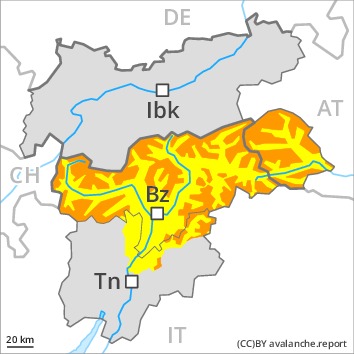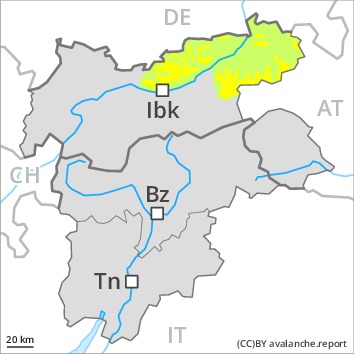
Danger level
 | 2000m
|
Avalanche Problem
 | | Persistent weak layer |
|  | |  |
 | | Wind-drifted snow |
|  | |  |
 | | Gliding snow |
|  | |  |

In some places avalanches can be released in the weakly bonded old snow and reach large size. Fresh wind slabs require caution.
Avalanches can be released in the weakly bonded old snow by a single winter sport participant. This applies above approximately 2000 m, especially in areas where the snow cover is rather shallow, as well as at transitions from a shallow to a deep snowpack. Between approximately 2000 and 2400 m the avalanche prone locations are more prevalent. Avalanches can penetrate deep layers and reach dangerously large size.
As a consequence of new snow and a sometimes strong wind, avalanche prone wind slabs formed. The avalanche prone locations are to be found in particular adjacent to ridgelines at high altitudes and in high Alpine regions.
In addition a latent danger of gliding avalanches exists. This applies in particular in the west and in the northwest. Areas with glide cracks are to be avoided.
As a consequence of solar radiation more frequent dry loose snow avalanches are to be expected, but they will be mostly small.
Experience and restraint are required.
Snowpack
dp.6: cold, loose snow and wind
dp.7: snow-poor zones in snow-rich surrounding
Over a wide area 5 to 15 cm of snow has fallen above approximately 1000 m. In the Gurgler Range up to 40 cm of snow has fallen.
The fresh wind slabs are lying on soft layers at high altitudes and in high Alpine regions.
Avalanche prone weak layers exist in the centre of the snowpack, especially between approximately 2000 and 2400 m in all aspects.
Tendency
Hardly any decrease in avalanche danger as the temperature drops.

Danger level
 | 2000m
|
Avalanche Problem
 | | Wind-drifted snow |
|  | |  |
 | | Gliding snow |
|  | |  |
 | | Persistent weak layer |
|  | |  |

Fresh wind slabs represent the main danger. Gliding snow requires caution.
High altitudes and the high Alpine regions: The fresh snow and in particular the sometimes deep wind slabs can be released easily, or, in isolated cases naturally in all aspects. The number and size of avalanche prone locations will increase with altitude. Avalanches can also penetrate deep layers and reach dangerously large size. Weak layers in the upper part of the snowpack can still be released in some places by individual winter sport participants in particular in areas where the snow cover is rather shallow.
Low and intermediate altitudes: A latent danger of gliding avalanches exists. Areas with glide cracks are to be avoided as far as possible.
Snowpack
dp.6: cold, loose snow and wind
dp.2: gliding snow
The fresh wind slabs are lying on soft layers in all aspects above the tree line.
The old snowpack is moist, in particular at low and intermediate altitudes.
Avalanche prone weak layers exist in the centre of the snowpack in all aspects, in particular above approximately 2000 m.
Tendency
Fresh wind slabs require caution. In addition a latent danger of gliding avalanches exists.

Danger level
 | 1600m
|
Avalanche Problem

Fresh wind slabs require caution.
As a consequence of new snow and a sometimes strong wind, avalanche prone wind slabs formed. The avalanche prone locations are to be found in particular adjacent to ridgelines. Such avalanche prone locations are clearly recognisable to the trained eye.
As a consequence of solar radiation more frequent dry loose snow avalanches are to be expected, but they will be mostly small.
Weak layers in the old snowpack can still be released in some places by individual winter sport participants. This applies between approximately 1800 and 2200 m, in particular in the Western Kitzbühel Alps.
Snowpack
dp.6: cold, loose snow and wind
Over a wide area 5 to 10 cm of snow has fallen above approximately 1000 m. Over a wide area new snow and wind slabs are lying on soft layers.
Individual weak layers exist in the bottom section of the snowpack.
At low altitude a little snow is lying.
Tendency
Hardly any decrease in avalanche danger as the temperature drops.














